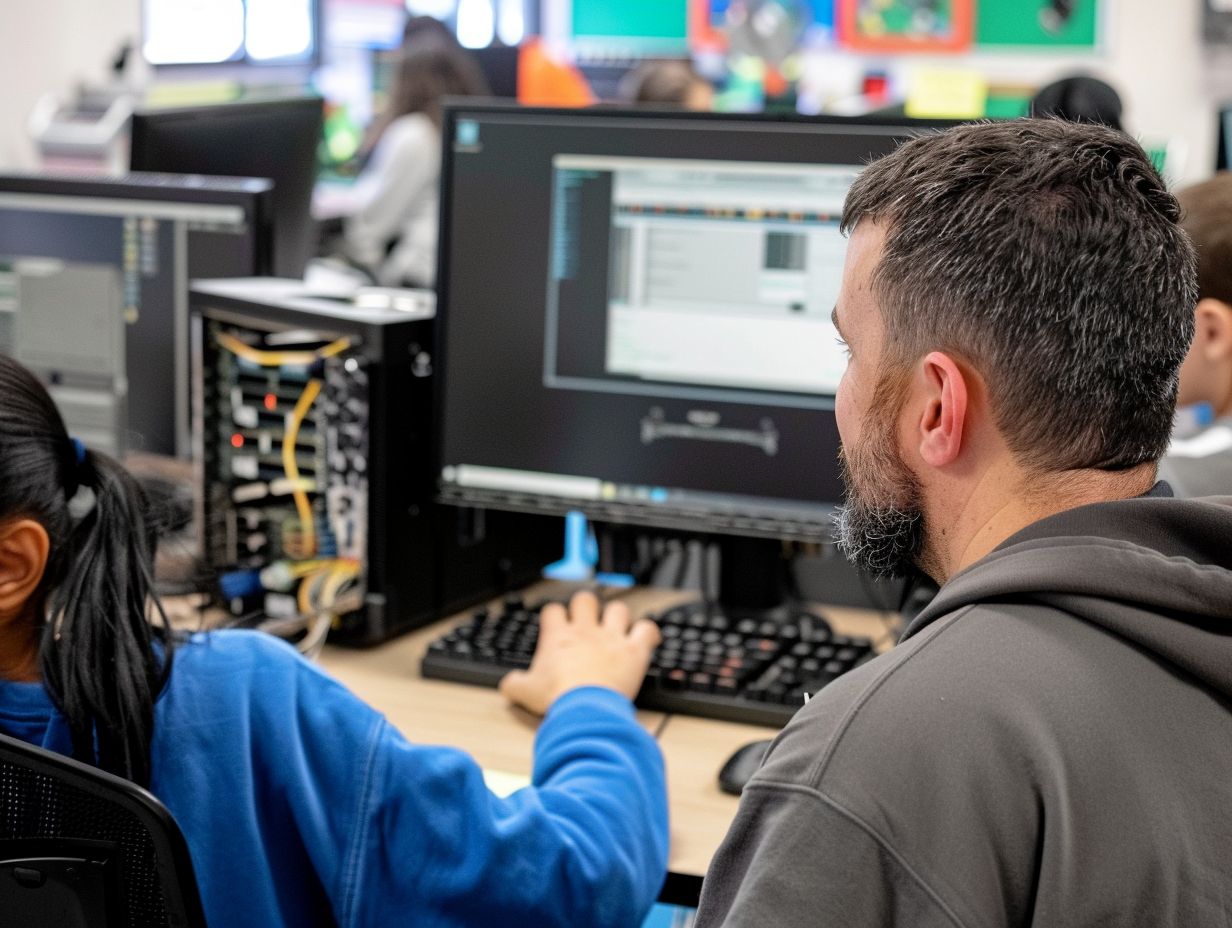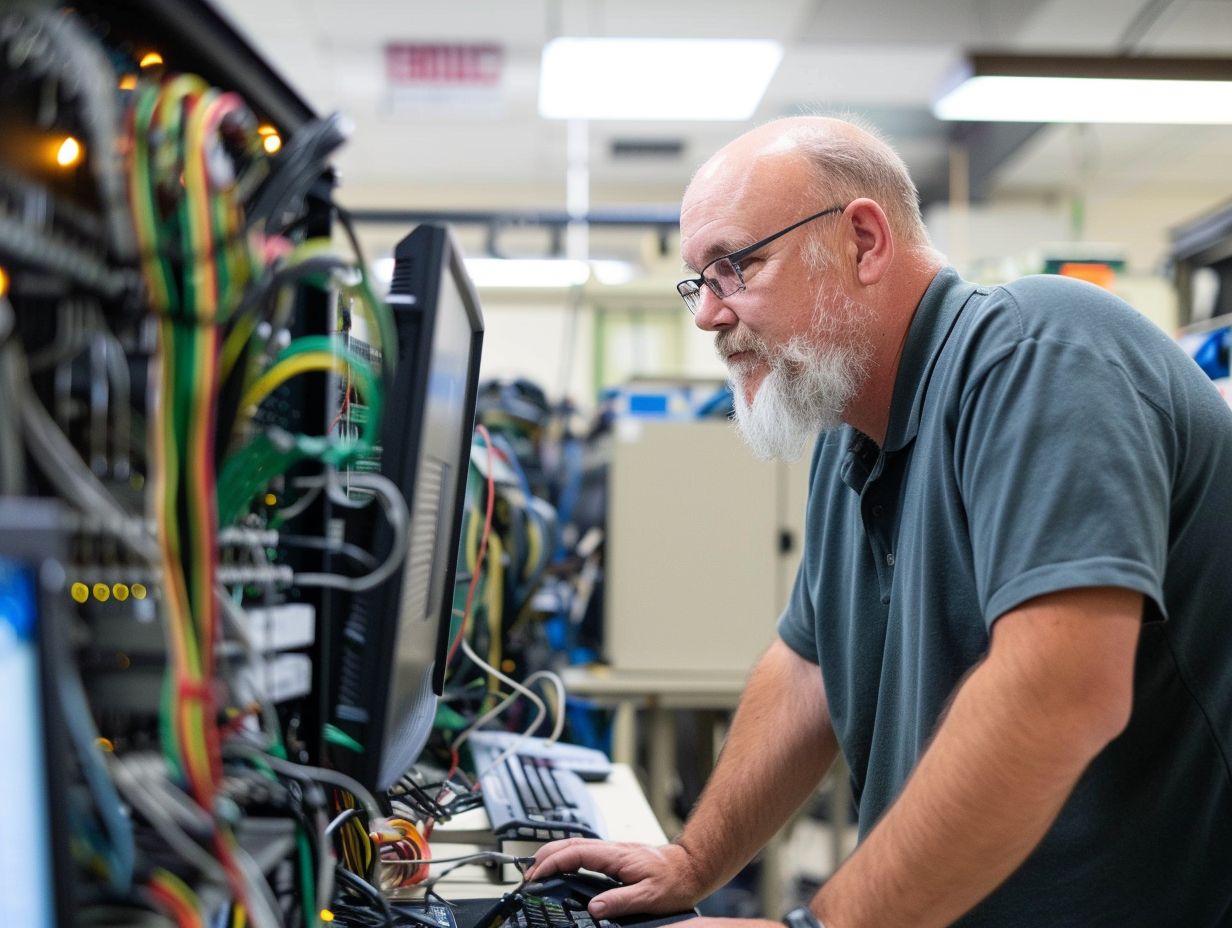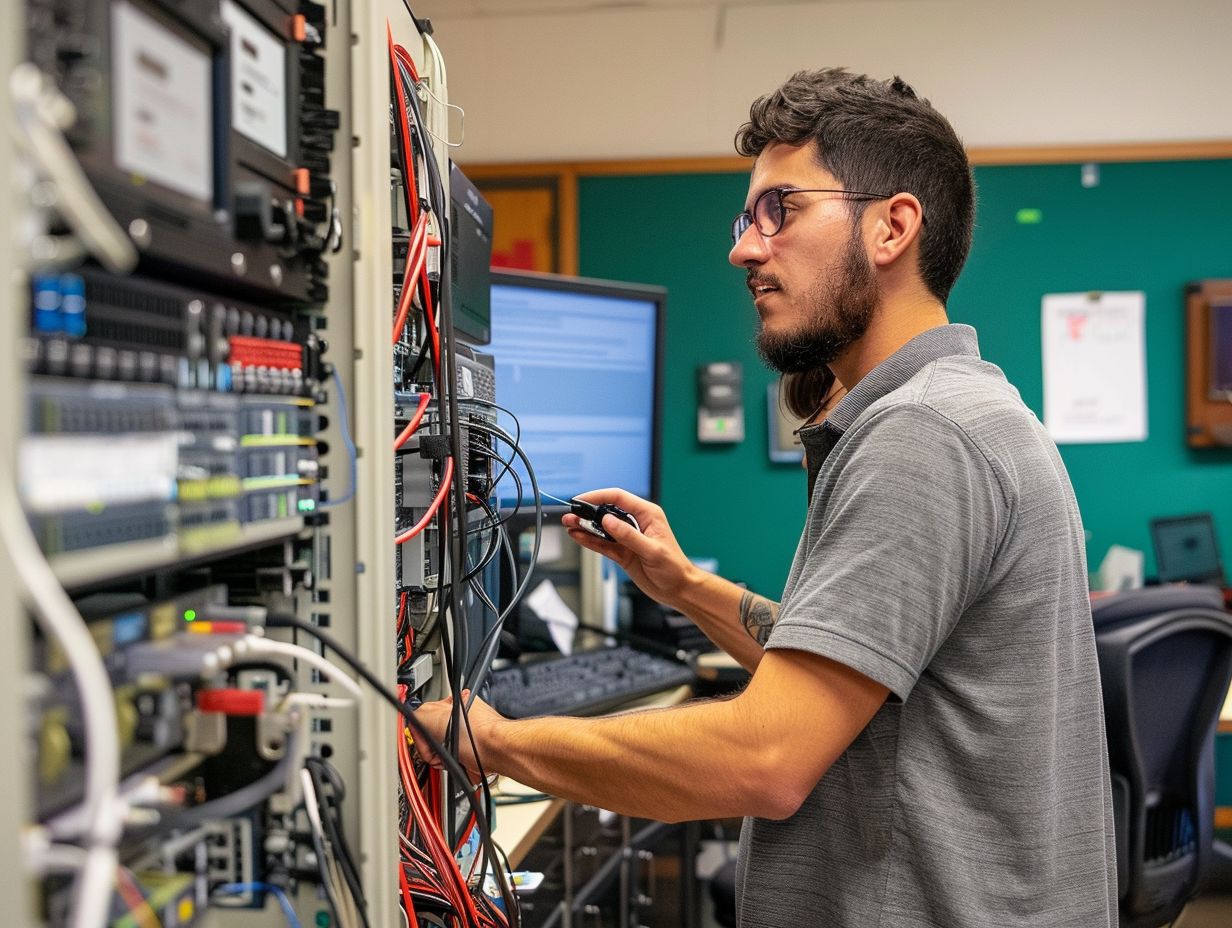In the shift towards online teaching, you, as an educator, encounter a distinctive array of challenges when instructing hardware skills within a virtual environment. Issues such as the absence of hands-on practice and technical obstacles make it progressively complex to proficiently illustrate concepts and involve students in interactive tasks. To surmount these hurdles, strategies like leveraging virtual simulations, partnering with industry professionals, and integrating interactive activities can be employed. This article will delve into the pros and cons of online teaching for hardware skills, while also examining potential resolutions and enhancements for the future of virtual education in this domain.
Key Takeaways:

- Teaching hardware skills online presents challenges due to lack of hands-on experience, difficulty in demonstrating concepts, and technical difficulties.
- Strategies for overcoming challenges include utilizing virtual simulations, incorporating interactive activities, and collaborating with industry partners.
- The future of online teaching for hardware skills could see potential solutions and improvements through advancements in technology and partnerships with industry professionals.
The Shift to Online Teaching
The shift to online teaching has revolutionized the educational landscape by offering you, as a student, the flexibility to learn from anywhere with just an internet connection. This transformation has brought about both challenges and opportunities for educators and learners alike. For you, online learning provides the convenience of accessing education without the constraints of physical location or time, allowing you to balance your studies with other commitments. Online platforms offer a variety of resources such as video lectures, interactive quizzes, and digital libraries, enhancing your learning experience. On the flip side, some students may struggle with self-discipline and the lack of face-to-face interactions with teachers and peers. Similarly, you benefit from the flexibility to design engaging lessons and provide personalized feedback but may face challenges in maintaining student engagement and managing online assessments effectively.
Advantages and Disadvantages
The shift to online teaching has presented a range of advantages and disadvantages for you. While online learning offers flexibility and accessibility, it also brings challenges such as digital literacy requirements and a decrease in face-to-face interaction. One of the key benefits of online learning for you is the opportunity to access education from any location at any time, allowing for a more personalized learning experience. Online platforms typically offer a variety of resources, including videos and interactive quizzes, that can enhance your learning process. However, you may encounter difficulties with the technical aspects of online learning, such as navigating various digital tools or dealing with unstable internet connections. Additionally, teachers may face obstacles in adjusting their teaching methods to effectively engage you in the virtual classroom setting.
Challenges in Teaching Hardware Skills Online
Teaching hardware skills online presents unique challenges to you as an instructor. The absence of hands-on experience and the difficulty in demonstrating concepts virtually create obstacles that need to be addressed. Technical issues and the necessity for digital literacy among your students can further complicate the teaching process. You may find that your students struggle to grasp technical components without the tactile engagement that traditional, in-person classes offer. The process of navigating troubleshooting exercises and diagnosing hardware issues remotely can hinder a comprehensive understanding of how systems operate. Additionally, disparities in access to quality devices among learners can exacerbate these challenges, potentially affecting the efficacy of the online learning environment. As an educator, it is crucial for you to seek out innovative methods to bridge this gap and improve your students’ digital literacy. By doing so, you can enhance the online learning experience and ensure a more seamless educational journey for your students.
Lack of Hands-On Experience
One of the primary challenges you may encounter when teaching hardware skills online is the lack of hands-on experience for your students. Without the opportunity for physical interaction with devices and equipment, learners might face difficulties in developing practical skills and effectively applying theoretical knowledge. This absence of hands-on experience could impede your students’ capacity to troubleshoot real-world hardware issues, as grasping the intricacies of hardware components typically necessitates practical application. To address this challenge, virtual simulations and digital platforms have become critical tools, offering interactive labs and virtual environments to simulate hands-on experience. To optimize learning outcomes, it is crucial for educators to design engaging virtual labs that enable students to manipulate virtual hardware, encouraging an environment of experimentation and problem-solving. By implementing a blended approach that incorporates a combination of virtual simulations and physical demonstrations, educators can provide a comprehensive learning experience for students pursuing hardware skills online.
Difficulty in Demonstrating Concepts
 Demonstrating hardware concepts online presents challenges in fostering student interaction, peer-to-peer support, and effective content delivery. You may encounter difficulties in engaging students and providing timely support in a virtual environment. When students learn hardware concepts remotely, they miss out on the hands-on experience and immediate feedback that traditional in-person demonstrations offer. The absence of physical equipment to interact with can make understanding complex components such as circuitry, sensors, and actuators more challenging. Without the ability to physically manipulate devices, you may struggle to grasp the intricacies of hardware functioning. The lack of face-to-face interaction can hinder peer collaboration and limit spontaneous discussions that often lead to deeper understanding. In this environment, you must find innovative ways to encourage student engagement and facilitate meaningful interactions among participants.
Demonstrating hardware concepts online presents challenges in fostering student interaction, peer-to-peer support, and effective content delivery. You may encounter difficulties in engaging students and providing timely support in a virtual environment. When students learn hardware concepts remotely, they miss out on the hands-on experience and immediate feedback that traditional in-person demonstrations offer. The absence of physical equipment to interact with can make understanding complex components such as circuitry, sensors, and actuators more challenging. Without the ability to physically manipulate devices, you may struggle to grasp the intricacies of hardware functioning. The lack of face-to-face interaction can hinder peer collaboration and limit spontaneous discussions that often lead to deeper understanding. In this environment, you must find innovative ways to encourage student engagement and facilitate meaningful interactions among participants.
Technical Difficulties
Technical difficulties, such as connectivity issues, limited internet access, and device compatibility, can hinder the effective teaching of hardware skills online. These challenges highlight the importance of reliable technology infrastructure for successful virtual learning. To alleviate these obstacles, you can implement strategies like pre-recorded demonstrations for offline viewing, providing alternative communication channels for students with poor connectivity, and offering a range of device options to accommodate various setups. Encouraging regular system checks and updates, utilizing cloud-based learning platforms to reduce device dependencies, and conducting virtual tech orientation sessions can enhance the overall effectiveness of online hardware skill instruction, fostering a more seamless and engaging learning experience for all participants.
Strategies for Overcoming Challenges
To overcome the challenges of teaching hardware skills online, you can implement various strategies. These include utilizing virtual simulations, incorporating interactive activities, and fostering collaboration with industry partners. Virtual simulations provide students with hands-on experience in a digital environment, allowing them to practice hardware skills in a safe and controlled setting. By engaging in interactive activities such as online tutorials and virtual labs, learners can actively participate in their education, reinforcing their comprehension and retention. Forming partnerships with industry experts gives students access to real-world insights and experiences, making their learning more relevant and connected to future career opportunities.
Utilizing Virtual Simulations and Demonstrations
Utilize virtual simulations and demonstrations to provide engaging hands-on learning experiences for students in an online setting. By utilizing interactive platforms and tools, educators can increase student engagement and understanding of hardware concepts. These virtual tools allow students to manipulate virtual objects and explore different scenarios in a controlled setting. Platforms like Labster and SimScale offer realistic simulations of scientific experiments and engineering projects, enabling students to enhance their practical skills. Additionally, tools like Autodesk Fusion 360 enable students to design and develop 3D models, fostering a practical understanding of engineering principles. Through these interactive experiences, students can enhance their problem-solving skills and apply theoretical knowledge to real-world applications.
Incorporating Interactive Activities
Incorporating interactive activities into your online classes can assist you in improving your time management skills, enhancing your technical proficiency, and overcoming barriers to effective learning. These activities are designed to promote active engagement and practical skill development. By utilizing interactive tools such as virtual simulations, game-based learning platforms, and AI-driven assessments, you can immerse yourself in hands-on experiences and gain valuable insights into hardware concepts. For example, online hardware skill courses may feature virtual labs where you can troubleshoot virtual machines, assemble computer components, and practice diagnostic techniques in a simulated environment. Collaborative platforms like discussion forums and live webinars encourage peer-to-peer interaction and knowledge sharing, fostering a sense of community and peer support among students.
Collaborating with Industry Partners
 Collaborating with industry partners can enrich your online teaching of hardware skills by providing real-world insights, relevant content, and expert support. You can leverage these partnerships to enhance the practical relevance and quality of your instructional materials. By tapping into the expertise of industry professionals, you can ensure that your students are receiving the most up-to-date knowledge and skills required in the rapidly evolving tech industry. Industry partnerships also open doors to curated content, such as case studies and best practices, that can add depth and context to the learning experience. The professional support offered by industry experts enables you to receive guidance on course design, instructional strategies, and assessment methods, ultimately leading to a more engaging and effective online learning environment.
Collaborating with industry partners can enrich your online teaching of hardware skills by providing real-world insights, relevant content, and expert support. You can leverage these partnerships to enhance the practical relevance and quality of your instructional materials. By tapping into the expertise of industry professionals, you can ensure that your students are receiving the most up-to-date knowledge and skills required in the rapidly evolving tech industry. Industry partnerships also open doors to curated content, such as case studies and best practices, that can add depth and context to the learning experience. The professional support offered by industry experts enables you to receive guidance on course design, instructional strategies, and assessment methods, ultimately leading to a more engaging and effective online learning environment.
The Future of Online Teaching for Hardware Skills
The future of online teaching for hardware skills holds promise for innovative solutions and advancements. By focusing on enhancing digital literacy, leveraging AI-powered personal assistants, and utilizing diverse digital resources, educators can revolutionize the learning experience for students. Integrating AI-powered tools enables instructors to provide personalized learning experiences tailored to each student’s unique needs. Digital resources such as virtual labs and interactive simulations offer hands-on practice in a virtual environment. This dynamic approach not only enhances understanding but also fosters creativity and problem-solving skills. The flexibility of online platforms allows for real-time feedback and assessment, making the learning process more efficient and effective. As the landscape of education continues to evolve, embracing these technologies will be crucial in preparing students for the digital future.
Potential Solutions and Improvements
To enhance your online teaching of hardware skills, consider potential solutions and improvements such as ensuring access to high-quality internet services, utilizing eLearning platforms effectively, leveraging virtual doors for student support, and tapping into resources available at public libraries.
- By prioritizing reliable internet services, students will be able to access online courses without interruptions, thus enabling a smooth learning experience.
- E-learning platforms provide interactive modules, quizzes, and videos that engage learners and improve knowledge retention.
- Virtual support systems like ‘virtual doors’ offer real-time assistance, allowing students to seek help whenever necessary.
- Public libraries are invaluable resources, offering computer access, study spaces, and additional learning materials that complement online education and make learning more accessible to a broader range of learners.
Frequently Asked Questions
What are the main challenges of teaching hardware skills online?
The main challenges of teaching hardware skills online include lack of hands-on practice, difficulty in troubleshooting technical issues, and limited interaction with students.
How can the lack of hands-on practice be overcome in teaching hardware skills online?
 One way to overcome the lack of hands-on practice is by utilizing virtual simulation software or providing step-by-step video tutorials for students to follow along with.
One way to overcome the lack of hands-on practice is by utilizing virtual simulation software or providing step-by-step video tutorials for students to follow along with.
What are some potential technical issues that may arise when teaching hardware skills online?
Potential technical issues may include slow internet connection, compatibility issues with devices and software, and difficulties in sharing visuals and demonstrations.
How can teachers effectively troubleshoot technical issues in an online hardware skills class?
Teachers can effectively troubleshoot technical issues by providing multiple communication channels for students to reach out for help, such as email, online forums, or virtual office hours.
What can be done to increase interaction with students in an online hardware skills class?
To increase interaction with students, teachers can incorporate interactive elements such as live Q&A sessions, group projects, and online discussions into the curriculum.
What are some ways to ensure that students are retaining the hardware skills they learn online?
Some ways to ensure that students are retaining the hardware skills they learn online include regular assessments, hands-on assignments, and providing additional resources for review and practice.
